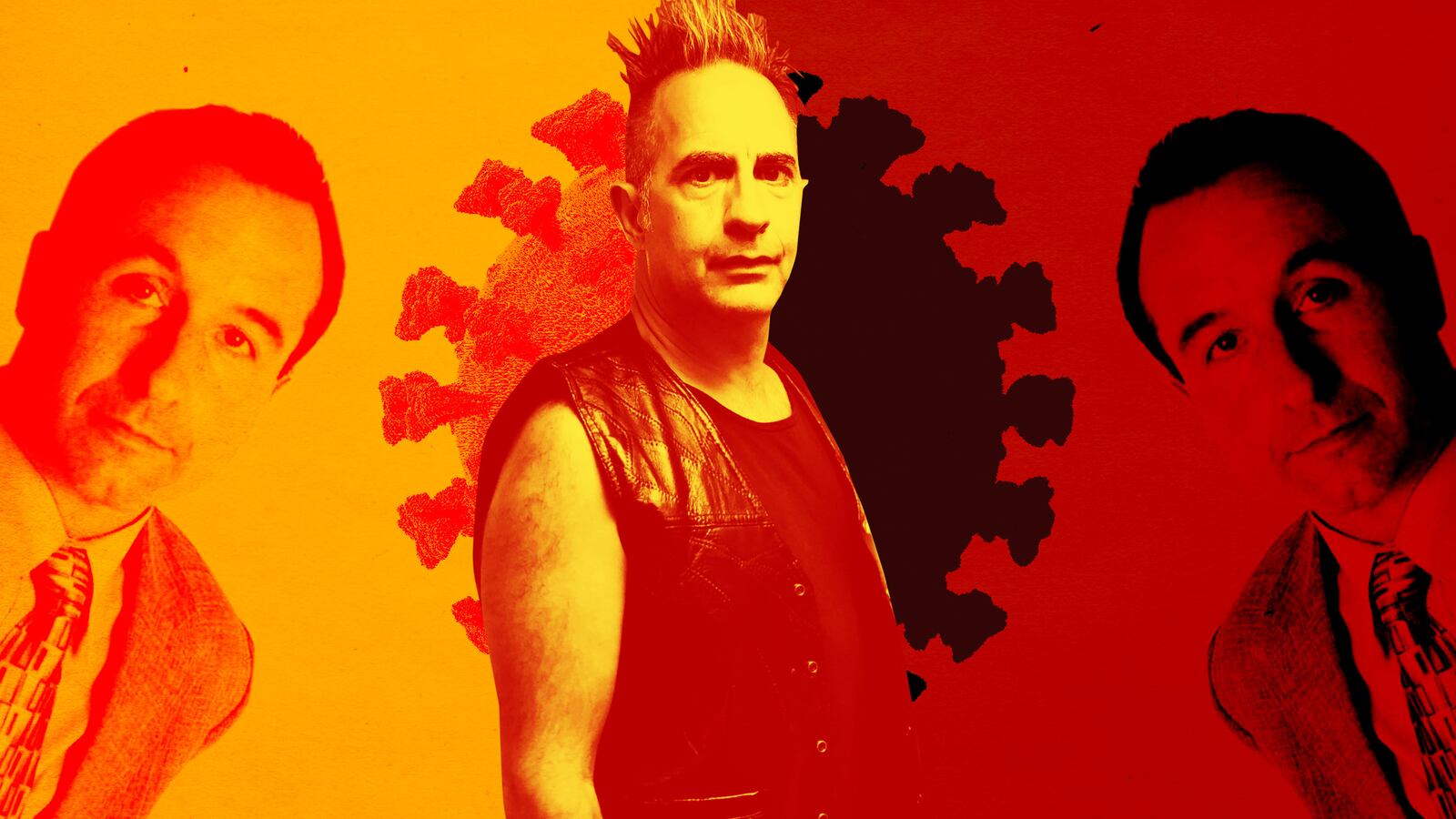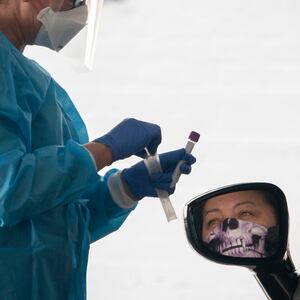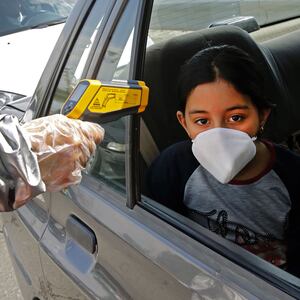A 1980s teen tech tycoon has teamed up with a one-time international carnivorous plant smuggler and a veterinarian to promote what they claim is a possible vaccine for COVID-19—but experts warn the budding research project could contribute to the flood of misinformation plaguing the coronavirus crisis.
The trio co-authored a “study” suggesting existing inoculations for measles, mumps, and rubella could help protect against the ravages of COVID-19. Their report, published through an obscure environmental charity called the World Organization, is also seeking coronavirus survivors to volunteer for blood work to test their theory.
They also want Dr. Anthony Fauci, the nation’s foremost infectious diseases specialist, or another team of epidemiologists to take on their research.
Jeff Gold, the computer scientist and chief investigator behind the report, told The Daily Beast that news reports of low fatality rates among those under 50 inspired him to search for a cause. Then he stumbled across the creation date of the combined vaccine for measles, mumps, and rubella: 1971.
“The only thing that could be physically different about people in the younger demographic, people under 50 versus people over 50, was a vaccine,” Gold argued.
But Dr. Jim Conway, a pediatric infectious disease specialist at the University of Wisconsin-Madison, said readers “need to be cautious when people are trying to draw associations that don’t have a lot of biological plausibility.”
“While data mining is fine, there’s much more risk of uncovering associations that have no true correlation versus finding things that actually have causation,” Conway said.
World Organization, not to be confused with the World Health Organization, has published the report—titled “MMR Vaccine Appears to Confer Strong Protection from COVID-19: Few Deaths from SARS-CoV-2 in Highly Vaccinated Populations”—on its website and promoted it in press releases and in local news and social media. The group based their findings off of published epidemiological data on COVID-19 death rates and MMR vaccination campaigns.
“Right now, it is a national priority to develop a safe and effective vaccine for the COVID-19 virus, and the race is on to do this, with dozens of companies and millions of dollars spent in this effort,” the report states. “As part of this effort, there should be an immediate investigation of using the already available MMR vaccine in controlled studies to show a protective benefit.”
Gold collected mortality data first from South Korea and Hong Kong, which have large-scale modern immunization programs and also low mortality rates—but which also implemented early and aggressive testing regimens and mask-wearing policies after the COVID-19 outbreak. He then examined locations such as Madagascar and Pacific Island nations which reported few or no deaths and also have wide-scale MMR inoculation programs. He contrasted these findings with Belgium, which the study says “didn’t even offer MMR vaccinations until 1985, and it wasn’t until 1995 that it began giving the recommended two doses of MMR vaccinations per person.”
The findings were so compelling to the 53-year-old Gold, he said, that he ran to his local Walgreens to get the MMR vaccine himself.
Scientists have floated existing vaccinations—particularly the nearly century-old Bacillus Calmette-Guerin live, attenuated tuberculosis vaccine and the 60-year-old oral polio vaccine—as a possible defense against coronavirus. Both vaccines have been shown to boost innate immunity against other viral infections.
The MMR vaccine also contains live weakened forms of measles, mumps and rubella.
Experts, however, warn not to draw quick conclusions from Gold’s hypothesis.
“Everybody is trying to pitch in, and I don’t blame these people for trying to do something helpful,” Conway told The Daily Beast. But “just because two things are happening doesn’t mean one has to do with the other,” he added.
For example, as a vaccination advocate who battles misinformation about vaccines and autism, Conway says he shows people a slide that indicates the disorder rises perfectly with an increase in the sale of organic foods. “You can make data say anything you want if you pick and choose the right stuff,” he said.
One factor missing from the study is pre-existing comorbidities. It’s also lacking information on how many tests each country conducted, Conway said.
“We’ve been using MMR vaccines for decades and they have done nothing to prevent SARS and other coronaviruses,” he added. “There’s not a lot of reason biologically that other vaccines would protect against COVID.”
Dr. Ajay K. Sethi, an infectious disease epidemiologist and associate professor of population health sciences at the University of Wisconsin-Madison, cautioned that there is no evidence Gold and his co-investigators “used a scientific approach to test their hypothesis that ‘different exposure to vaccines between younger and older people may account for this different morbidity rate [in COVID-19].’”
According to Sethi, some red flags in the report include that the study design is not provided and the authors do not cite relevant research that led to their hypothesis. There’s also no statistical tests to determine if the findings are due to chance.
“Other explanations for the relationship between older age and COVID deaths are not explored even though much has been written about this subject,” Sethi continued. “The countries chosen and presentation of information appear to be cherry-picked to support their conclusion. Evidence of objectivity is lacking. Citations are not provided for many of the claims made.”
He said conclusions should not be drawn until three questions are addressed: Are the findings instead due to statistical chance? Can bias explain the findings? And could the reason for the finding be explained by some other variable?
Meanwhile, Gold is pushing for wider recognition of his MMR vaccine theory. It’s Gold’s first apparent foray into immunology; for most of the past decade, he and the World Organization have run a pet adoption network—Rescue Me!—and the Georgia Nature Center, an attraction in Watkinsville geared toward school children. But he spent the 1980s making startling discoveries of another kind.
U.S. News & World Report profiled Gold in 1983, when he was the then-16-year-old founder of Double-Gold Software, having developed an early anti-piracy program called Lock-It Up and an algorithm that could solve a Rubik’s Cube. When the magazine paid Gold a visit, the teenage genius was angry he’d need a cosigner for the furniture he’d ordered for his suite of offices. Back then, he told the outlet he didn’t believe in failure.
“If you start a company and go bankrupt, it doesn’t mean you have failed. You will have learned from the experience,” said the Silicon Valley wunderkind, who had dropped out of high school to pursue his tech businesses.
According to a 1984 Washington Post feature on “young computer capitalists,” Gold was raking in more than $100,000 a year and driving a Datsun sports car with vanity plates: DBL GOLD. In his memoir The Accidental Millionaire, entrepreneur Gary Fong recalled meeting Gold at the University of California, Santa Barbara, around the same time, and described him as a “generational genius.”
By the early 1990s, Gold had cultivated an interest in carnivorous plants—one he shared with a friend, William Baumgartl, a doctor at the Allegiant Spine Institute in Nevada who is now involved in Gold’s MMR vaccine push.
Baumgartl, an anesthesiologist and stem cell specialist, said his friend’s findings impressed him when Gold shared them earlier this year. “The data suggests a correlation between those who get the MMR and have protection,” Baumgartl told The Daily Beast. “It may be the basis of a very inexpensive, and very easy to initiate, vaccine therapy for this disease.”
The files of the Nevada State Board of Medical Examiners indicate that Baumgartl’s history as a physician is unblemished. But his personal record is not so pristine: In 1995, he and two friends pleaded guilty to smuggling hundreds of carnivorous Nepenthes pitcher plants into the U.S. from Indonesia and Malaysia, in violation of the Endangered Species Act. Just a few years earlier, Gold had faced a similar accusation from the Venezuelan government, which alleged he had stolen carnivorous orchids from the slopes of the South American nation’s Tepui mesas. Gold disputed the accusations—and still does—but subsequently dissolved a nonprofit he had founded to study the insect-swallowing flora.
Baumgartl, for his part, blamed his imbroglio on bad legal advice from one of his accomplices, an Oakland deputy district attorney. “I accounted for what I did, accepted responsibility, and it was a very minor charge,” the doctor said, adding that he served no hard time for the crime.
Meanwhile, the ragtag team of researchers has linked a University of Cambridge study on MMR vaccines to their own, calling it a “corroborating report.”
In April, U.K. scientists uploaded a study to the server medRxiv which identified some chemical similarities between COVID-19 and the measles, mumps, and rubella viruses, and a correlation between rubella antibodies and a lower impact by the novel coronavirus. The report, which is not peer-reviewed, concludes that “vaccination of at risk age groups with an MMR vaccination merits further consideration as a time-appropriate and safe intervention.”
“I suddenly felt like this is such an important connection that's been made, and they've made, most importantly, that really knocks this out of the park,” Gold said of finding the Cambridge paper. “They came up with the same thing we did coming at it with completely different angles.”
Still, Rocio Hernandez, one of the researchers on the Cambridge study, objected to the World Organization’s interpretation of their research in a statement to the Daily Beast. He pointed to disclaimers on medRxiv which warn that papers there “should not be relied on to guide clinical practice or health-related behavior and should not be reported in news media as established information.” He further underscored that the Cambridge team’s work is still in its embryonic stages, and requires considerable further lab research.
“In short, no, they are not using the work appropriately, it cannot be used to corroborate their own conclusions for obvious reasons,” Hernandez told the Daily Beast. “It is preliminary work, based on preliminary lab tests, and the hypothesis still requires further lab/clinical work to confirm or refute it. Our study leads are currently seeking funds for this.”
Undeterred, Gold has been aggressively pushing his paper, sending it to Dr. Fauci, and to the National Institute of Health. And this week, on the advice of several friends, he began his campaign to get it noticed in the press.
“They tell me you need to get this to the media before the people in the NIH are going to pay attention to it,” Gold said. "What we're saying is if this is true, and what Cambridge more importantly has come across, if this is true, then there is a solution to this pandemic that could be put into action within weeks.”
In an email, the NIH’s National Institute of Allergy and Infectious Diseases confirmed that the World Organization reached out to its staff but that it “is currently not studying a connection between the MMR vaccine and COVID-19.”
Another associate of Gold’s, New Mexico-based veterinarian Dr. Larry Tilley—the author and editor of multiple volumes on animal ailments—told The Daily Beast that he researched medical literature as part of the study, which was Gold’s brainchild. But he stressed they’re seeking government researchers or experienced epidemiologists to adopt the hypothesis. “There’s a need now to have someone, an epidemiologist, take this to the next level,” said Tilley, who also got a booster shot because of Gold’s findings. “What we found is all preliminary.”
“We just simply saw something that didn’t make sense—why certain countries were having such a high death rate,” Tilley added. “I say it to people now: I’m not an expert. But it seems like there’s something there.”
Tilley said the World Organization is trying to reach anyone who can run with their findings, whether it’s people in “D.C., Dr. Fauci’s group, NIH, or CDC.”
Readers of the study have already flocked to the group’s Facebook page, asking if they should get a measles booster shot and if doctors administer them on request. One woman commented, “I should be okay then. MMR is one of the vaccines I got in 2010, it was required for my citizenship process.”
Another commenter said she was born in 1973 and asked if she’d likely had the MMR vaccine. World.Org replied, “You probably did, but at that time they only gave one rather than two in a row, which was less effective. I’d recommend getting a series of two again now. Whether or not our study ends up proving this 100%, we already have a lot of evidence pointing that way, it can’t hurt to get them again.”
“Hubby and I are going to CVS tomorrow,” the woman replied. “Thanks for the info!!!”
Before The Daily Beast reached out, the World Organization had begun soliciting COVID-19 survivors through its website to participate in a new study in which volunteers would travel to the nearest Quest Diagnostics lab and get tested for MMR antibodies.
Sethi, the infectious disease epidemiologist, expressed concern that the study’s authors “are using their paper as the basis for recruiting COVID-19 survivors to participate in human subjects research.”
“In a time of crisis, fear and uncertainty can cause individuals to not exercise better judgment when evaluating the legitimacy of information found online,” Sethi told The Daily Beast. “COVID survivors may be eager to participate in research to get answers about the illness they had experienced and to contribute to the effort to address the pandemic.”
Sethi, who also researches the spread of public health conspiracies, said that based on the study’s appearance, “a reader may mistake the paper as being scientifically rigorous.”
“Moreover, the name of the organization that carried out the study is called ‘World Organization.’ Someone could easily confuse that with ‘World Health Organization’ and be misled into thinking that the WHO carried out the study,” Sethi added.
Indeed, at least one outlet, TechStartups.com, has confused Gold’s group with the World Health Organization and misattributed its research accordingly.
When encountering seemingly scientific papers, consumers should check to see if they were published in peer-reviewed journals, Sethi said. Those journals should have a reputation for publishing high-quality research in the field of study. Authors may instead choose to publish their research papers on preprint servers, like medRxiv, arXiv, and bioRxiv, “which are well known by members of the scientific community,” Sethi said.
“Posting articles to these preprint servers is the norm in many fields, and by doing so, the research is immediately accessible to anyone and is inherently subject to continuous peer review once it is posted. By publishing their paper on their own website instead of a well known preprint servers, the authors have bypassed the peer-review process,” Sethi added.
World Organization’s report came with a caveat at the end: “In the interest of providing early information to other researchers and the public, many COVID-19 researchers including ourselves are publishing ‘early release’ articles like this one which are not considered final. The information contained herein, and certainty of any conclusions being reached, are subject to change as this study continues.”
Sethi said, “The disclaimer in the article is a good thing, but it's not a substitute for posting the research on a credible website where it can undergo peer-review.”
But Gold defended himself and his work, claiming he hoped only to encourage further inquiry into a potential life-saving answer to the current crisis.
“We’re not trying to pretend to be the epidemiologists here,” he said. “If this is not a solution, I think it's equally important for someone to go through this data and analyze it.”
Shortly after talking with The Daily Beast, Gold reconfigured the World Organization’s website to redirect to ResearchGate, an academic networking and preprint site, where his study had gone up one day prior.
Conway, the pediatric infectious diseases expert, said that until such studies are peer-reviewed, they’re “as good as social media.”
“We’re in a historic era in one way, because science is so much more transparent than it used to be because of the internet,” Conway said. This includes posting studies on websites before they’ve been tested widely by other scientists.
And rushing to conclusions can have dangerous consequences. Conway noted how New York doctors prescribed the anti-malaria drug hydroxychloroquine in light of “observational” studies, which had not been peer-reviewed clinical trials. Then came a Food and Drug Administration warning that tests had indicated the medicine could cause “potentially life-threatening heart rhythm problems,” even though it hadn’t “proven safe or effective for treating COVID-19.”
“One glimmer of information and hope suddenly leads to a snowballing effect,” Conway told The Daily Beast. “Since we don’t have anything clear, people want to act. They would prefer to not just stand there but do something.”









